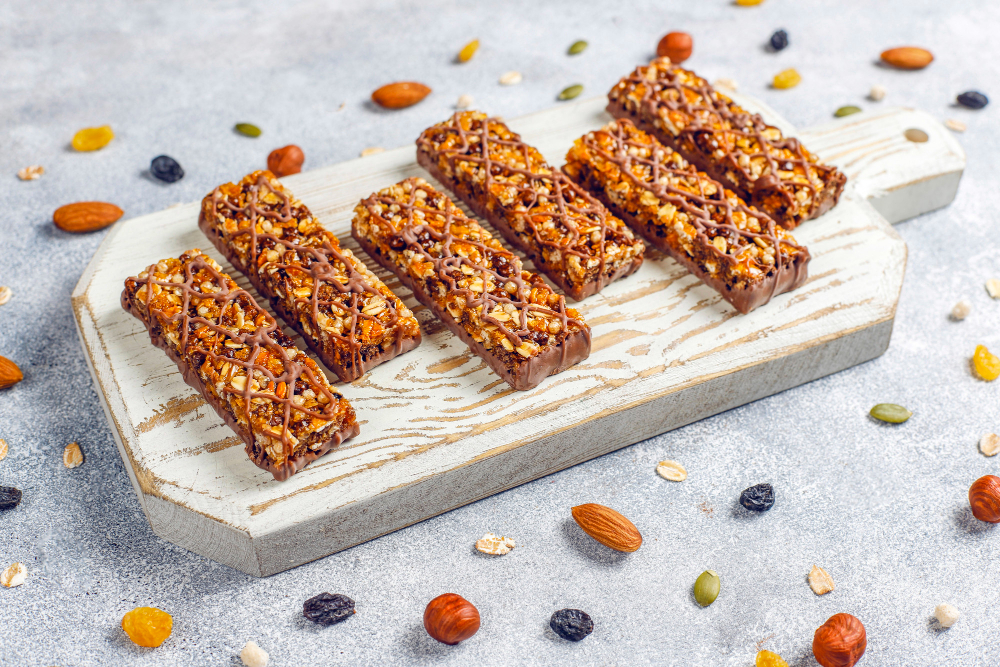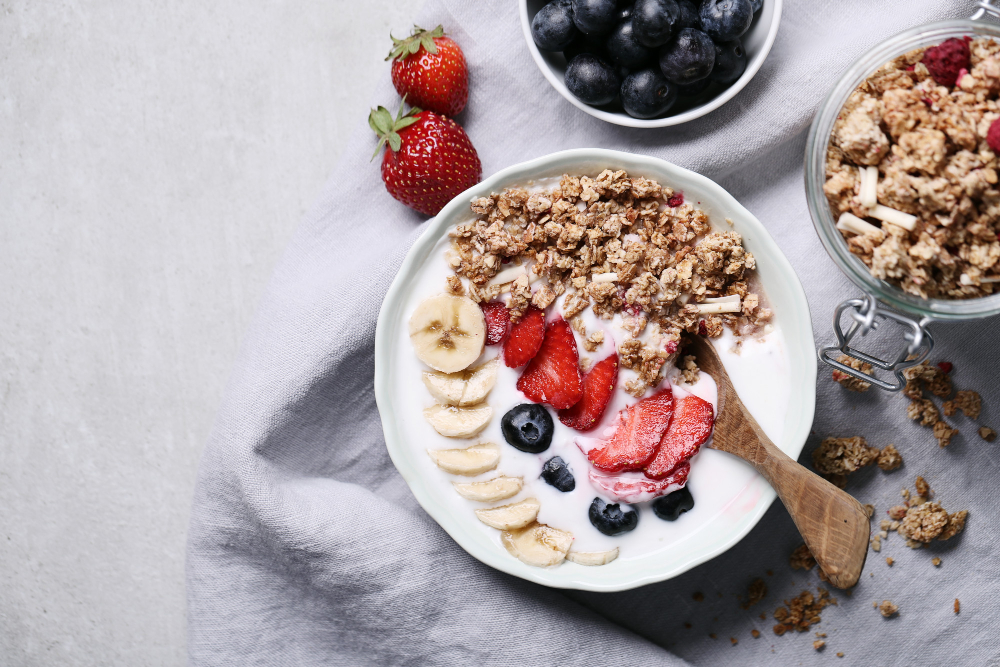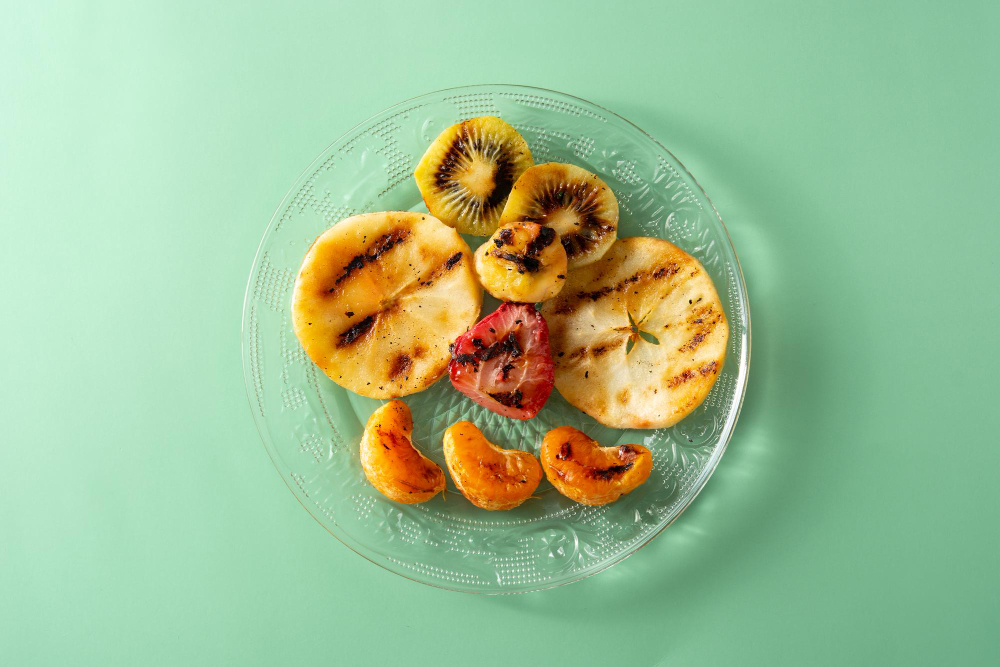
The Average American adult, teenager, and child consume 68 grams of sugar per day vastly exceeding health recommendations. Excessive sugar consumption can result in higher blood pressure, inflammation, weight gain, diabetes, and fatty liver disease which are all linked to an increased risk of heart attack and stroke. Given this situation, it’s important to look at how we can cut back on sugar.
What is the right amount of Sugar?
Here are some recommendations from the American Heart Association.
- Adult women should aim for an added-sugar limit of about 6 teaspoons or 24 grams; around 100 calories.
- Adult men should aim for about 9 teaspoons or 36 grams of sugar; around 150 calories
- Children under 18 should limit their sugar intake to less than 6 teaspoons or 24 grams per day, and sugary beverages should be limited to no more than 8 ounces a week.
How to Cut Back on Sugar
Learn about the various forms of sugar
Sugars come in many forms so one of the most important aspects of cutting back is recognizing and knowing the various ways sugar is described. Some names you may see on labels include:
- Corn syrup or high-fructose corn syrup
- Brown rice syrup
- Agave nectar
- Cane syrup
- Honey
- Fructose
- Fruit juice concentrate
- Maltodextrin
- Maltose
- Dextrose
- Glucose
- Sucrose
- Galactose
- Molasses
Compare food labels and choose products with the lowest amounts of added sugars.

Once you’ve armed yourself with the knowledge of sugar’s various names and forms, you can use the labels to compare products and choose the ones with the lowest added sugars.
Don’t just go by the raw number though. Consider the serving size, how much you’ll realistically eat, and even the total sugar per package vs your RDI for a full picture.
Ease Into It
People often have trouble giving things up all at once and sugar is no different. The most effective way is to consider the benchmarks for a healthy sugar intake above and ramp down from your current intake.
For example, If you’re used to adding 4 spoons of sugar to your coffee, cut back to 3 then 2, and maybe even try your coffee plain after some time. You can also try sugar substitutes in your coffee for a bit of sweetness or to help you transition to having it plain.
Cut Back on Sugary Desserts

Nearly 20% of the average American’s sugar intake comes from grain and dairy-based desserts like cakes, cookies, and donuts that provide little or no nutritional value. Eating these sugar-packed desserts leads to blood sugar spikes that cause you to become tired and crave more sugar pulling you into a destructive cycle.
Among life’s simple pleasures, is eating something sweet so we wouldn’t advise cutting out all sugar. When you have a craving, try a healthier alternative like fresh fruit, greek yogurt, or dark chocolate. Keep in mind, your taste buds might need some retraining to appreciate these alternatives in place of the sugar bombs they’re replacing.
Don’t Fear Fat
Health trends in the 1980s and 1990s kicked off a frenzy of low-fat substitutes for many processed foods like peanut butter, salad dressing, yogurt, ice cream, cereal bars, baked goods, and more. However, low-fat often means increased sugar.
If you’re trying to cut back on sugar, you can try to avoid many of these foods or eat their full-fat versions in moderation. Best yet, you can make your own! With little more than a blender or food processor, you can make many of these items yourself and have control over what’s going into them.
Swap out the Soda
Sodas can certainly be a crisp, clean, and refreshing beverage but they provide no nutritional value and often pack 30-40 grams of sugar per 12-ounce (355ml) can. Water is going to be the healthiest beverage choice. But if you feel a need for something sweet and flavorful in your beverage, try a few of these alternatives.
- Fruit-infused water- Our favorite flavor combination includes cucumber and lime
- Flavored sparkling water - (try to look for unsweetened ones or ones that use sugar substitutes) Raspberry lime Spindrift is our favorite.
- Diet sodas (we would still encourage consuming these minimally and sparingly)
Rethink Your Other Drinks
Soda isn’t the only problem beverage. Many drinks that carry a healthy halo can also be quite high in sugar. Coconut water, lemonade, bottled tea, fruit juice, and flavored waters contain many more grams of sugar than you might expect and sometimes more than even soda.
Here are some examples:
- Coconut water: An 8-ounce serving of O.N.E. coconut water contains 8 grams of sugar.
- San Pellegrino Sparkling Drinks: The brand is normally associated with plain sparkling water so It can be easy to pick one of these drinks up without thinking but one can contains as much as 29 grams of sugar.
- Gold Peak Iced Tea: An 18.5-ounce bottle contains 24 grams of sugar in the “slightly sweet” variation while their sweet tea packs 42 grams of sugar; nearly your entire daily allowance!
- Juice: 12 ounces of 100% apple juice contains nearly the same 40 grams of sugar that’s in a soda of the same size.
Beware of “Healthy” Snacks

Many foods are instantly associated with health and nutrition so they’re often consumed without much thought. This includes many processed foods like cereals, granola bars, protein bars, dried fruit, smoothies, acai bowls etc.
These foods do provide genuine health benefits like fiber, vitamins, and antioxidants. While we wouldn’t say that you should cut these out, you should be more mindful and aware of what is in these foods.
Cereals - Kristin Berman did an excellent breakdown of this problem. Cereal is tricky for two reasons; there is much more sugar per serving than anyone realizes. For example, one bowl of Raisin Bran has as much sugar as a SNICKERS bar. Additionally, people eat way more than the recommended serving size. When participants were asked to pour a “normal amount” of cereal into a bowl, they exceeded the recommended serving by 24-92%!
Granola bars and protein bars seem like a convenient, healthy snack we can take with us but we’re sad to say that they often have as much sugar as a candy bar.
Dried fruit by its nature is easy to eat in excess. It’s sugar and calorie dense as a result of having its water content removed. For instance, a small box of raisins packs 25 grams of sugar according to the USDA.
Acai bowls despite their high antioxidant and nutrient content are often loaded with added sugars and topped with sweets like honey, and chocolate chips. The average acai bowl from your local smoothie shop can contain anywhere from 20-60 grams of sugar!
Again, many of these foods do provide genuine health benefits but you may want to look at these as more of a treat or dessert than a “health food.”
Add Fruit Instead

Top your foods with fruit instead of sugar or honey.
Cereal, pancakes, yogurt, and oatmeal are a little sweet naturally to different extents. So it shouldn’t take that much more to have a nice, tasty breakfast. Try using fruit like blueberries, bananas, and strawberries to add a hint of sweetness. You’ll also get the added benefit of fiber which should keep you full for longer.
Enjoy the Sweet Taste of the Maillard Reaction

The browning of meats, the crusts of breads and the sweetening of fruits that get grilled or roasted is a result of the Maillard reaction. It’s basically heat releasing the natural sweetness of foods and utilizing it can help you to enjoy a bit of sweetness without adding sugars to your diet.
Roasting apples, pears or peaches can sweeten or even caramelize them depending on the technique. It’s not limited to fruits though. Roasting and grilling can even bring out the natural sweetness in vegetables like onions, sweet potatoes, and bell peppers.
Keep in mind concerns have been raised about compounds that can be ingested from eating grilled foods.
Be Careful with the Condiments
Having a healthy salad for lunch? Having a nice light chicken dinner? Either one of these can become an excess sugar situation without a little condiment control.
Here are some examples of the amount of sugar certain condiments can pack:
- Honey Mustard Dipping Sauce: 6 grams
- Barbecue Sauce: 16 grams
- Ketchup: 6 grams
- Fat-Free Salad Dressing: 13 grams
All figures come from information on nutritionvalue.org
Sweeten with Spices
Spices can add a new dimension and subtle sweetness to your foods and beverages.
It might not be immediately obvious since the word makes you think of the flavor descriptor of “spicy” but spices run a wide range of flavors. Best yet, they often have nutritional benefits that sugar doesn’t like minerals, antioxidants, and essential oils.
How to:
Cinnamon: A few sprinkles in your yogurt or coffee will sweeten things up without any added sugar.
Cloves: Add to hardy dishes like soups, stews and curries for a sweet/spicy taste
Vanilla: Add vanilla to coffee or even try it in your oatmeal for an aromatic, sugar-free sweetness.
Cardamom: Some have found success swapping cardamom for sugar in their baked goods.
Swap in Alternative Sweeteners (sparingly)
Whether you’re looking for something natural, artificial, with no aftertaste or only a slight aftertaste, there’s something for you! These sweeteners can be an effective method to reduce your caloric intake while controlling your blood glucose levels.
However, these alternative sweeteners should still be consumed in moderation. At least some people can experience raised blood glucose levels from the popular additive maltodextrin. Additionally, excessive consumption of artificial sweeteners still seems to cause the pancreas to release insulin into the bloodstream.
Bake with Apple Sauce
Next time you’re feeling the urge to do a bit of baking, try swapping unsweetened apple sauce in place of sugar in a 1:1 ratio. Due to the moisture in apple sauce, you’ll probably need to cut back on the liquid in your recipe. It’s typically advised to reduce the milk or water by about ¼ cup. Apple sauce also comes with the benefit of providing additional flavor and texture to your muffins, cakes, or banana bread.
Get Enough Sleep

Inadequate sleep has been shown to increase levels of ghrelin, a hormone that increases hunger levels, and decreases levels of leptin, a hormone that helps with appetite control. It’s also thought that people tend to crave sugary junk foods when sleep-deprived as they instinctively chase that quick jolt of energy.
As a result of this multitude of factors, one of the most important things to do for your sugar intake and really your overall health is to get enough sleep every day.
Control Your Stress Levels
With terms like “stress-eating” and “comfort foods,” it’s probably no shock that excessive stress often causes us to reach for sugary treats as a coping mechanism. In fact, this study published by the NIH reports that 60-70% of respondents said that they eat more sweet foods like candy, chocolate, cakes, and cookies during times of high stress.
Next time you’re craving something sweet, it might be worth evaluating your stress levels and what the causes might be. Check out our comprehensive list of ways to destress whether in the moment or long term.
Bottom Line
Excessive sugar intake has many negative health consequences that can lead to obesity, diabetes and even heart disease. While there are sugar substitutes out there that closely mimic the taste of sugar, they come with their own concerns. To combat those sugar cravings, it’ll be important to control your stress levels, get enough sleep and retrain your taste buds.
This article is provided for informational purposes only and is not intended to be used as medical advice. If you have immediate concerns about your health, please seek the help of your physician.
*These statements have not been evaluated by the Food and Drug Administration. This product is not intended to diagnose, treat, cure or prevent disease.
© 2022 Best in Nature All rights reserved




Validate your login
Sign In
Create New Account